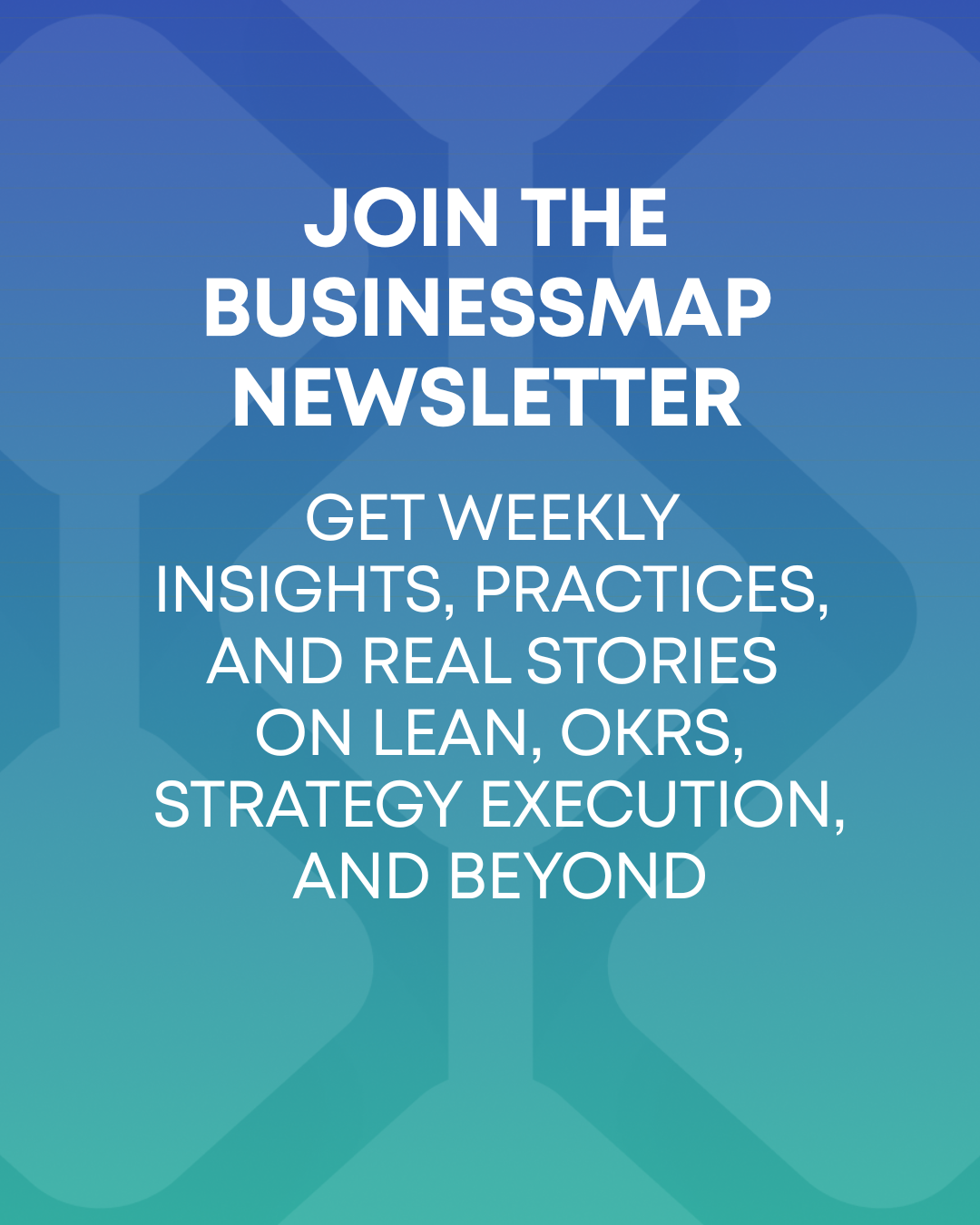Turning vision into action has been one of the fiercest challenges that managers face. That's actually been cited in numerous studies over the years, and even though there are improvements, strategy execution continues to be the main culprit behind the failure of many good ideas.
This is why management approaches like OKRs (Objectives and Key Results) have gained significant popularity. However, implementing OKRs effectively can be challenging.
In the following sections, we provide practical solutions for:
- Visualizing your strategic/organizational OKRs
- Creating your team-level OKRs
- Linking your strategic and team OKRs together
- Connecting OKRs to daily work
These insights will help you align ъоур strategy with execution more effectively.
What Are OKRs?
OKRs stands for "Objectives and Key Results". It's a famous goal-setting framework (used by companies such as Google, Amazon, Dell, etc.) that aims to bring organizational alignment.
The objectives represent high-level goals that communicate "what" your company/division/team wants to achieve.
On the other hand, the key results are the building blocks of the objectives. They answer the question "how" you are going to achieve your high-level goals. You can think of them as the outcomes that measure whether you're achieving your goals.
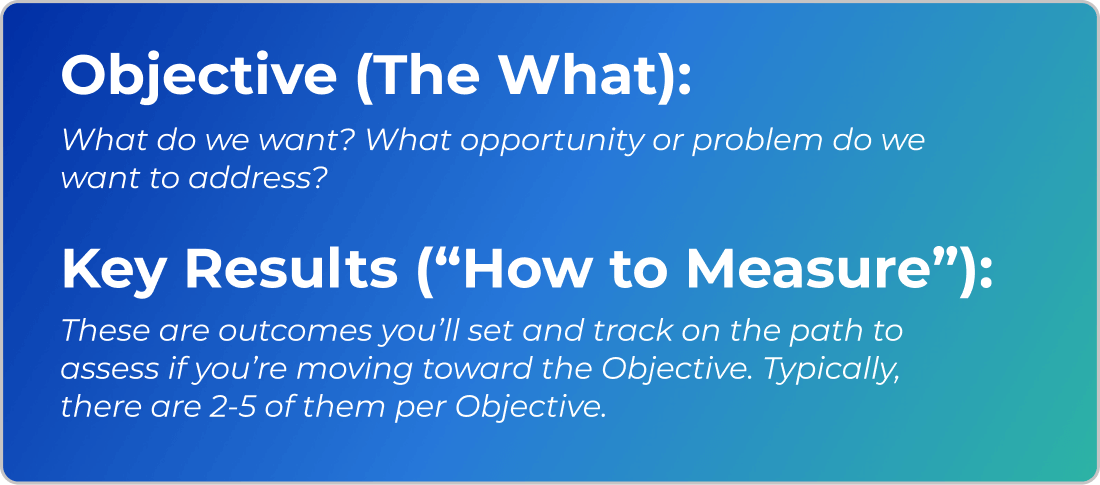
The OKRs framework is a great way to enable your company to work on the right things at the right time. To do that, you need to gain visibility across your goals and connect them to the actual daily activities.
Let's see how you do this in practice.
Why Do You Need to Visualize OKRs?
Visualization of work is crucial for businesses to identify patterns and trends, enabling early detection of potential problems and proactive measures. To keep teams aligned with the strategy, it's essential to recognize that a company operates as a network of interdependent services. Building interconnected boards for visualizing work and mapping OKRs at various levels is highly beneficial.
For instance, creating a specific OKR board with strategic OKRs can define the company's direction, and different teams can then develop their own OKRs based on these strategic goals.
4 Practical Ways to Visualize OKRs with Businessmap
Let’s explore some practical examples of mapping OKRs and connecting them to actual work initiatives to link strategy with execution more effectively.
1. How to Visualize Your Strategic OKRs?
To visualize your high-level (strategic) objectives, the first thing you need to do is set up an (OKR) portfolio board. In Businessmap, we use Management (Portfolio) boards to visualize multiple projects, products, initiatives, etc., and track work across teams or departments. In this case, you can think of a Management board as a top-level OKR board that you will use for strategic OKR visualization.
In the uppermost workflow lane of the Management (OKR) board, you can create initiatives that will serve as your objectives. For the sake of the example, let's say that one of your strategic (and inspirational) goals is to "Increase the Revenue Across Top Markets".
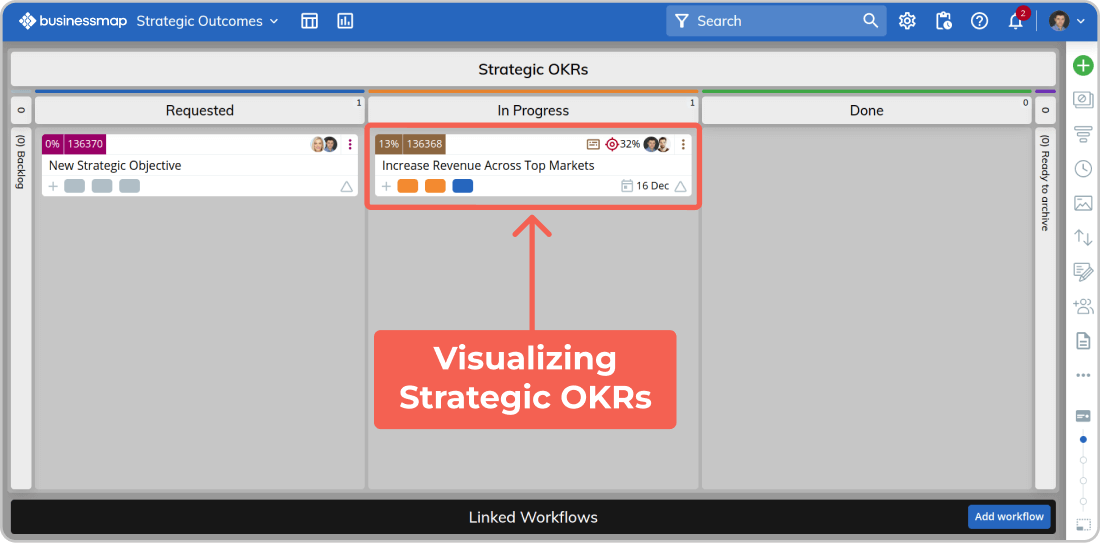 Visualizing strategic objectives on a Management (OKR) board
Visualizing strategic objectives on a Management (OKR) board
As you can see, this is a pretty wide goal we need to measure. To do this on our platform, you can use "Measurable Outcomes" within an objective to create key results.
To support your strategic goal, let's say that you have the following key results:
- Increase Outbound Sales by 30% in the US and CA
- Increase the Inbound Monthly Conversion Rate in the UK
- Improve the Product's Integration Capabilities
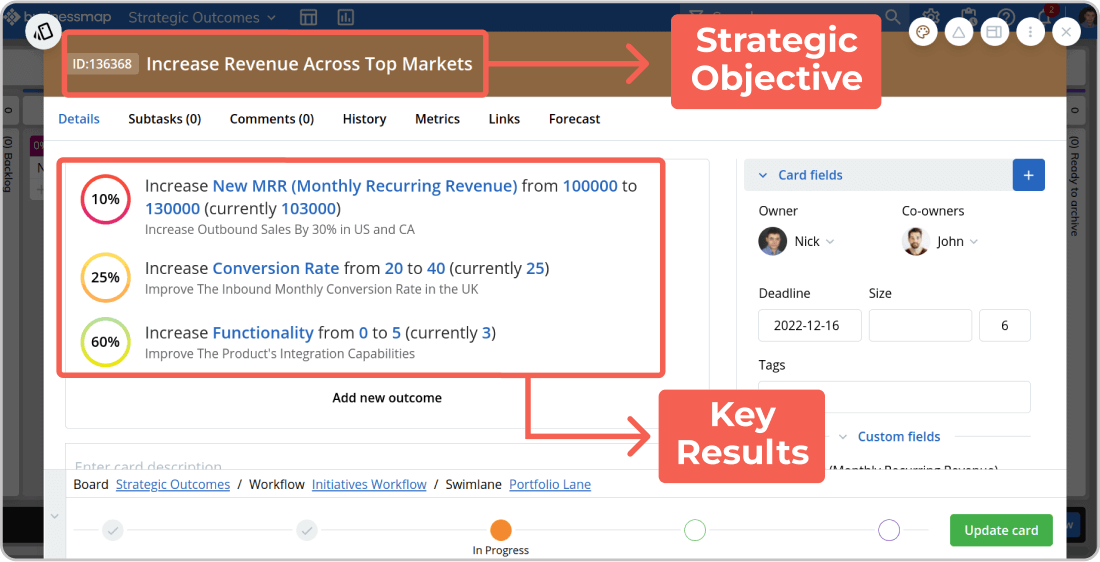 Creating key results within a strategic objective (initiative card)
Creating key results within a strategic objective (initiative card)
In Businessmap, your strategic objectives and their corresponding key results are displayed in the top lane of your Management (OKR) board. This central location ensures that stakeholders remain aligned with your company's top priorities. Both the objectives and key results include progress indicators, allowing you to track how close you are to achieving your goals.
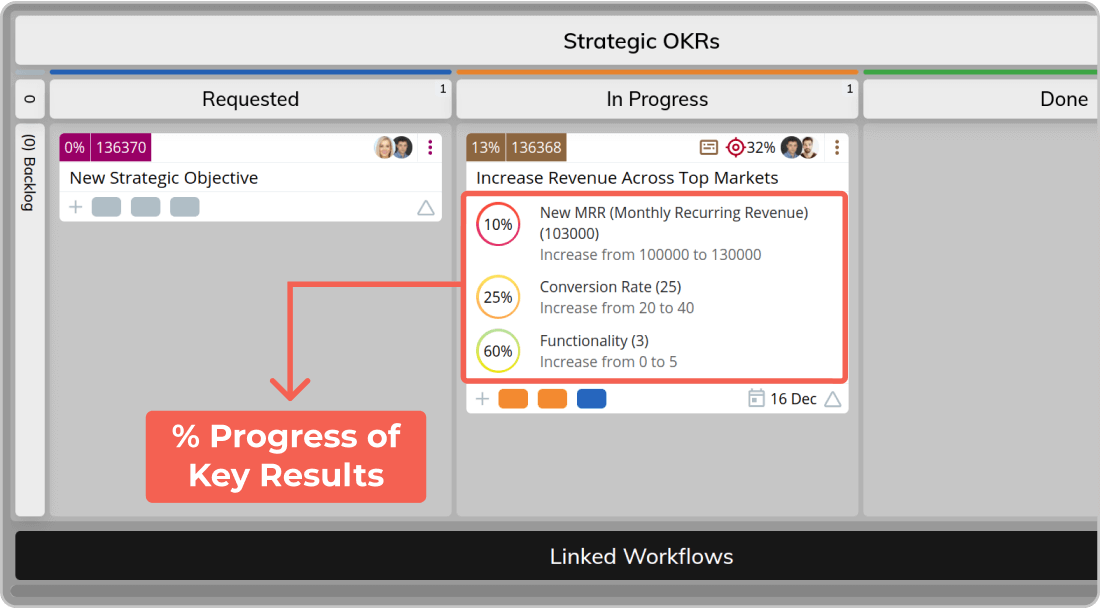 Tracking key result's progress
Tracking key result's progress
Note: "Measurable Outcomes" is an exclusive feature of Businessmap. To learn more about it, check out our knowledgebase article.
2. How to Visualize Team-Level OKRs?
To execute the strategic OKRs mentioned above, you will need the input of multiple teams. Let's say those teams are Sales, Marketing, and Engineering.
They can build their own kanban boards where they visualize team-level objectives. While their objectives need to support the company's strategic direction, they don't have to be a direct descendant of the strategic objectives. In other words, aim for alignment instead of cascading your OKRs.
So, team-level objectives could be:
- Sales Team Objective: "Increase closed deals with digital transformation professionals".
- Marketing Team Objective: "Improve conversion rate from organic search".
- Engineering Team Objective: "Have a product where users can enable integrations with custom systems".
If we take the Engineering team, they can respectively visualize their objective inside the top-level workflow of a team kanban board.
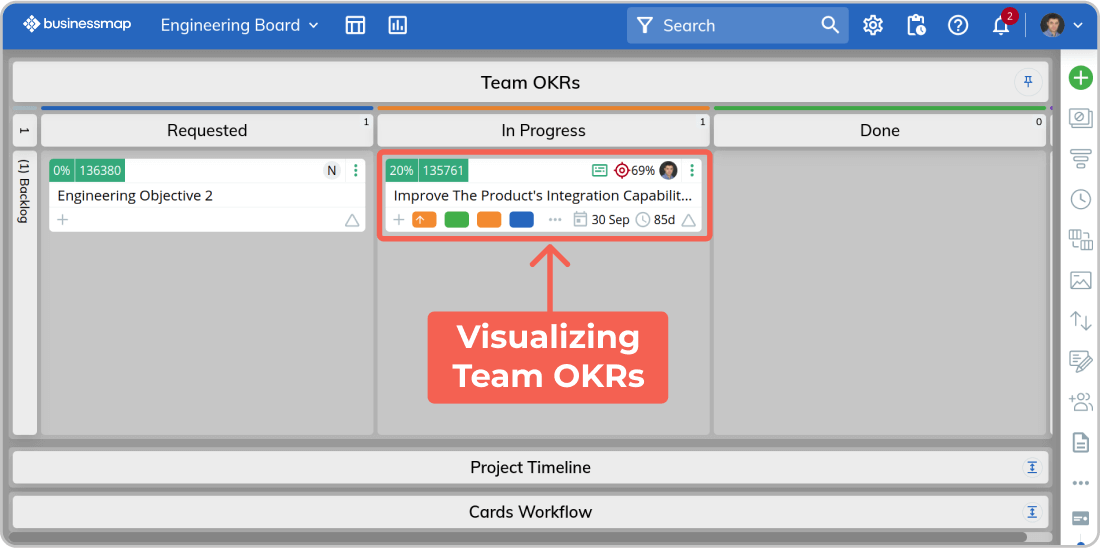 Visualizing team-level objectives on a team board
Visualizing team-level objectives on a team board
After that, they could build several team-level key results (or measurable outcomes) within the objective and track their progress over time. In this case, the key results could be the following:
- Engineering KR1: 10 New Endpoints for the API.
- Engineering KR2: Keep Found Bugs in the API Below 18.
- Engineering KR3: 3 Exclusive Add-Ons for API-Less Integrations.
 Creating key results within a team-level objective
Creating key results within a team-level objective
3. How to Link Strategic and Team OKRs Together?
At this point, the main benefit of the Management (Portfolio) boards comes into play. They allow you to visualize high-level initiatives and connect them to smaller pieces of work across teams in a single place. In our case, that would be the strategic and team-level OKRs.
Using the "Linked Workflows" feature, you can connect the Management Board and other team boards. This allows you to bring strategic and team goals together to keep an eye on their progress. Using the parent-child link relationships in Businessmap will help you create a complete hierarchy of your OKRs.
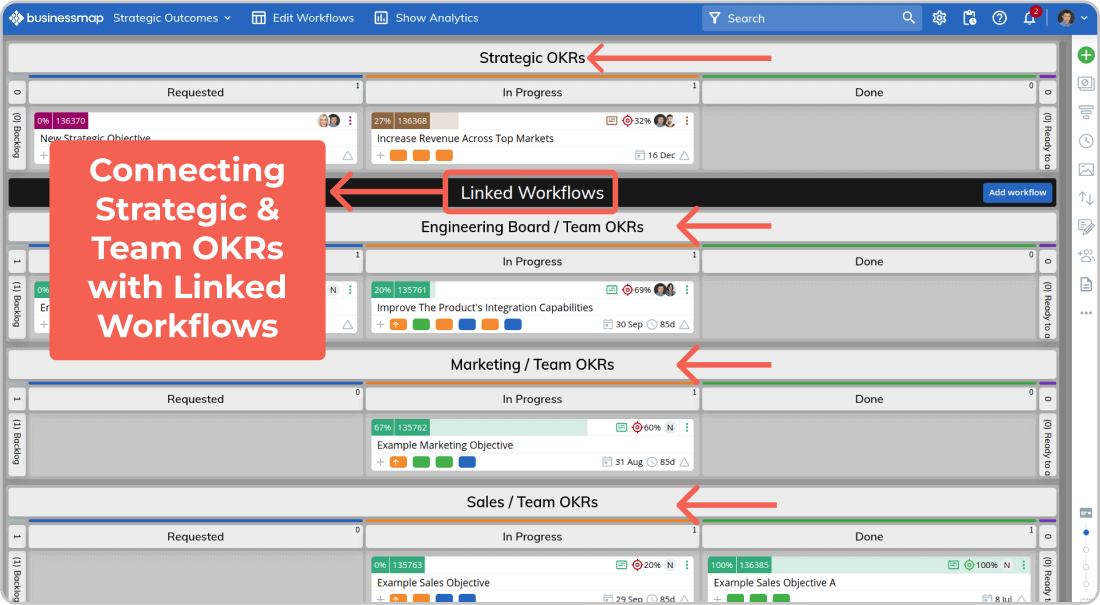 Visualizing both strategic/organizational and team OKRs
Visualizing both strategic/organizational and team OKRs
4. How to Connect OKRs to Work Execution?
So far, we've set up some strategic and team OKRs, and we've also linked them together. Still, there is one missing piece of the puzzle - the connection to daily operations.
One way to do this is to connect your team-level OKRs to smaller initiatives/projects right inside your team boards. For example, looking at the Engineering key results above, you will definitely have different work initiatives contributing to their execution.
To visualize all this work on a team board, you can place a timeline workflow below your team OKRs and track the execution of various projects/initiatives.
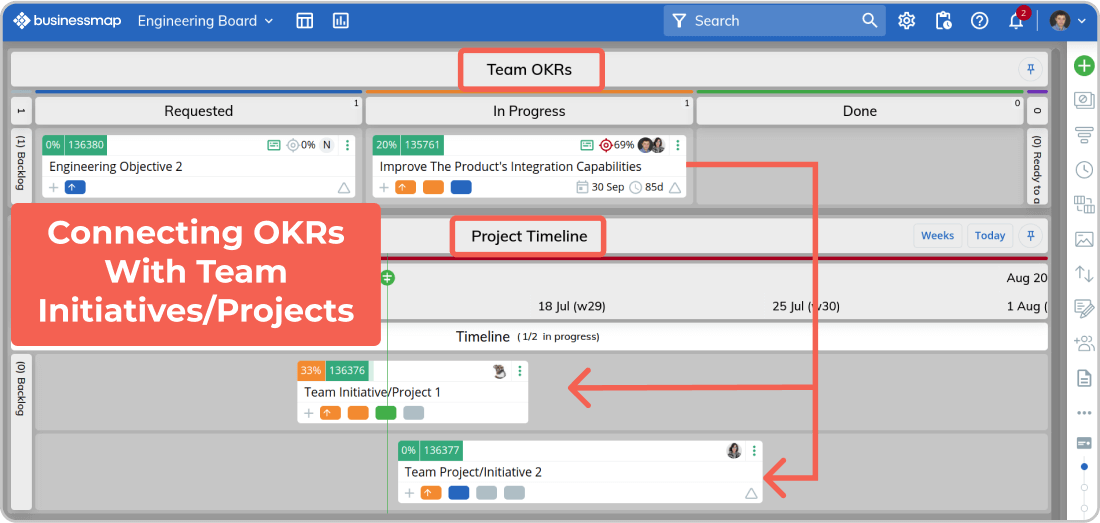 Connecting OKRs with team projects on a timeline
Connecting OKRs with team projects on a timeline
You can then use another workflow layer below to break down those team projects, initiatives, or epics into individual work items (user stories, tasks, etc.). By doing that, you will create a hub for your team's daily operations and manage the actual flow of work.
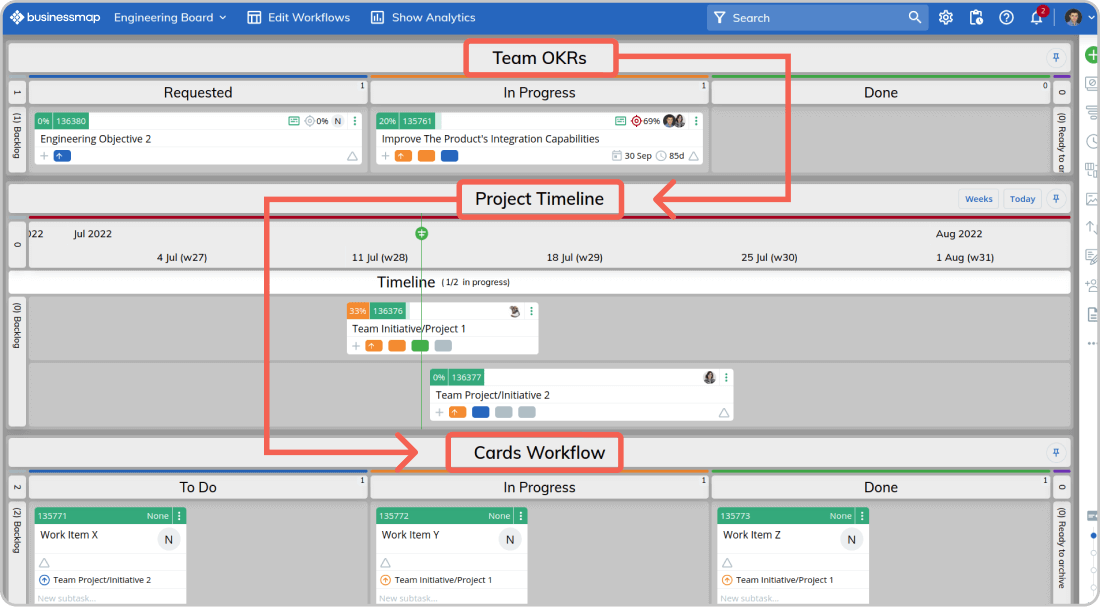 Connecting team-level OKRs with all work initiatives
Connecting team-level OKRs with all work initiatives
With the parent-child relationship links, you can keep this entire structure intact. As a result, with every small piece of work your teams deliver, you can measure how that brings you closer to achieving your high-level goals.
Maximizing OKR Effectiveness: Key Benefits and Use Cases
As we've gone through a possible scenario of connecting daily work to OKRs, let's look at some common benefits and use cases.
- Align Strategy and Execution
Using the OKRs framework with multiple boards brings transparency to the high-level goal-setting process and connects it to daily operations. With a combination of regular meetings, this enables companies to do the right things at the right time.
- Track Team Progress Toward Company Goals
Connecting OKR structure to daily operations allows managers to track how teams contribute to company goals. This enables them to plan projects better and take quick action whenever they spot deviations from the high-level goals.
- Improve Communication and Agility
Mapping OKRs and connecting them to daily activities gives managers an easy way to track the progress of their high-level goals in real time. It facilitates strategic discussions of the company's performance during management meetings, which can help enable operational agility whenever business priorities change.
Start Unfolding Your Strategy with OKR Visualization
Visualizing OKRs and integrating them into daily operations is a vast topic, and we've only touched on just a few configurations among many. The key takeaway is the underlying concept: when setting OKRs, ensure they are connected to execution across teams to realize your strategy fully.
Remember, there is no "one-size-fits-all" solution. Start with your current approach and gradually evolve from there to achieve optimal results.
Businessmap is the most flexible software, helping your company gain visibility across all projects/portfolios, align on goals, and deliver quality work faster.

Nikolay Tsonev
Product Marketing | PMI Agile | SAFe Agilist certified
Nick is a seasoned product marketer and subject matter expert at Businessmap, specializing in OKRs, strategy execution, and Lean management. Passionate about continuous improvement, he has authored numerous resources on modern-day management. As a certified PMI practitioner and SAFe Agilist, Nick frequently shares his insights at Lean/Agile conferences and management forums.



